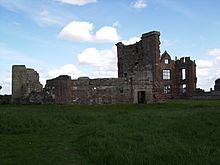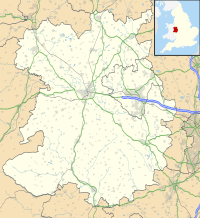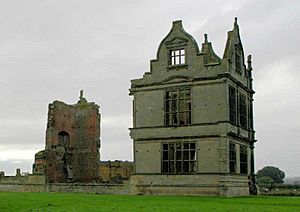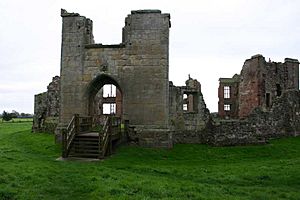Moreton Corbet Castle facts for kids
Quick facts for kids Moreton Corbet Castle |
|
|---|---|
| Shropshire, England | |

View from the west
|
|
| Coordinates | 52°48′16″N 2°39′15″W / 52.8045°N 2.6541°W |
| Type | Castle |
| Site information | |
| Owner | English Heritage |
| Condition | Ruined |
Moreton Corbet Castle is an old building managed by English Heritage. It is found near the village of Moreton Corbet in Shropshire, England. This historic site is about 8 miles northeast of Shrewsbury.
The castle is a Grade I listed building, which means it's very important. What you see today are the ruins of two different buildings. One part is a strong medieval (Middle Ages) fortress. The other part is a grand Elizabethan era country house. Both buildings have been empty since the 1700s.
Contents
History of Moreton Corbet Castle
From Medieval Fortress to Castle
In 1086, two important Anglo-Saxon leaders, Hunning and Wulfgeat, lived at Moreton Corbet. They might have had a fortified building there. By the early 1200s, an Englishman named Toret built a new structure. His descendant, Peter Toret, was the lord of Moreton Corbet by 1166 and likely lived in the castle.
In February 1216, William Marshall attacked Moreton Corbet castle for King John of England. At this time, it was called Moreton Toret Castle. In 1235, Bartholomew Toret died. His son-in-law, Richard de Corbet, inherited the castle and changed its name to Moreton Corbet.
The castle was later involved in the English Civil War. During this time, it was captured and recaptured at least four times.
Moreton Corbet Castle still belongs to the Corbet family today.
The Grand Elizabethan House
In the 1500s, Sir Andrew Corbet made many changes to the castle's gatehouse and outer walls. When he passed away in 1579, his son, Robert Corbet (died 1583), took over. Robert had traveled as a diplomat and seen amazing classical architecture in other countries. He decided to build a brand new, fancy mansion at Moreton Corbet.
Sadly, Robert died from the plague in 1583. After him, his two brothers, Richard and Vincent Corbet, continued building the new manor. They left most of the old medieval fortress as it was.
Moreton Corbet in the Civil War
During the English Civil War, Moreton Corbet Castle was used to help defend the Royalist town of Shrewsbury. The castle was attacked more than once and was badly damaged during the fighting. At one point, only ten Parliamentarian soldiers managed to capture the castle! It was finally taken from a local "home guard" group by a very skilled Parliamentarian army unit.
Exploring the Ruins
You can visit the ruins of Moreton Corbet Castle for free during daylight hours.
The castle today shows a clear difference between the old medieval parts and the newer Elizabethan house. The Elizabethan building stretches out in a straight line to the south of the older fortress.
The Medieval Gatehouse
The main path leads you past the medieval castle to the gatehouse. This gatehouse was the entrance to the medieval building and was rebuilt a lot in the 1500s. Sir Andrew Corbet kept this important defensive part. Above the arch, you can see his special symbol and the date 1579 carved into a stone. Below it is another stone with the Corbet family's crest: an elephant and a castle. Since Sir Andrew died in 1578, these carvings must have been added after his death, meaning the building was still being finished.
The gatehouse no longer has a roof. Inside, you can still see the special stone supports that held up the roof and the tower's battlements.
Inside the Old Castle
When you enter the inner courtyard and look north, you can see how the medieval castle was laid out. The main tower, or keep, on the west side was connected to the gatehouse by a wall. This wall then curved south, surrounding the area and creating a courtyard. The walls are now in ruins, and you can see the church in the background. Many of the stones have small holes from musket shots fired during the Civil War. Sir Andrew also built a large living area against this wall, with kitchens below and rooms above.
The rectangular keep at the western end of the wall has two stories and a basement. It's hard to know exactly when it was built, but it could be from the 11th, 12th, or early 13th century. You can still see the fireplaces on the lower floor where people lived. The tower was used and rebuilt many times, eventually becoming a storage area for the 16th-century house. People were still living in it around 1700.
Sir Andrew Corbet also built a house in the courtyard to the east of the keep in the mid-1500s. These Tudor-style buildings, east and south of the gatehouse, opened into a great hall. You can still see the large fireplace on the first floor and a smaller one below.
The Grand Elizabethan House
South of the old castle, Sir Andrew's son, Robert, started building a new, wide, but shallow house. A writer named William Camden called it "a most gorgeous and stately house after the Italian model." Robert had been a diplomat and was inspired by Italian buildings he saw, like Palladio's Basilica Palladiana in Vicenza. The outside of the building was made of stone, but the inside walls were brick.
You can walk straight through the Elizabethan house and come out through the main door on the south side. This door, like the rest of the front, was beautifully decorated with carvings. The house is badly damaged, but the western end is the most complete. Looking at it from the west gives you a good idea of how it originally looked. Even though it was inspired by Italian designs and had many carvings, some of the carving work had a rustic, natural finish.
On the southwest corner of the Elizabethan house, you can see a carving of a chimera, a mythical creature. A wyvern, another mythical creature, is carved on the other end of the front.
Current Status
Even though the buildings were repaired after the Civil War, they stopped being used in the 1700s and parts of them were torn down. The Corbet Family still owns the castle, but English Heritage helps manage it. The family moved to Acton Reynald Hall nearby.
Images for kids


















